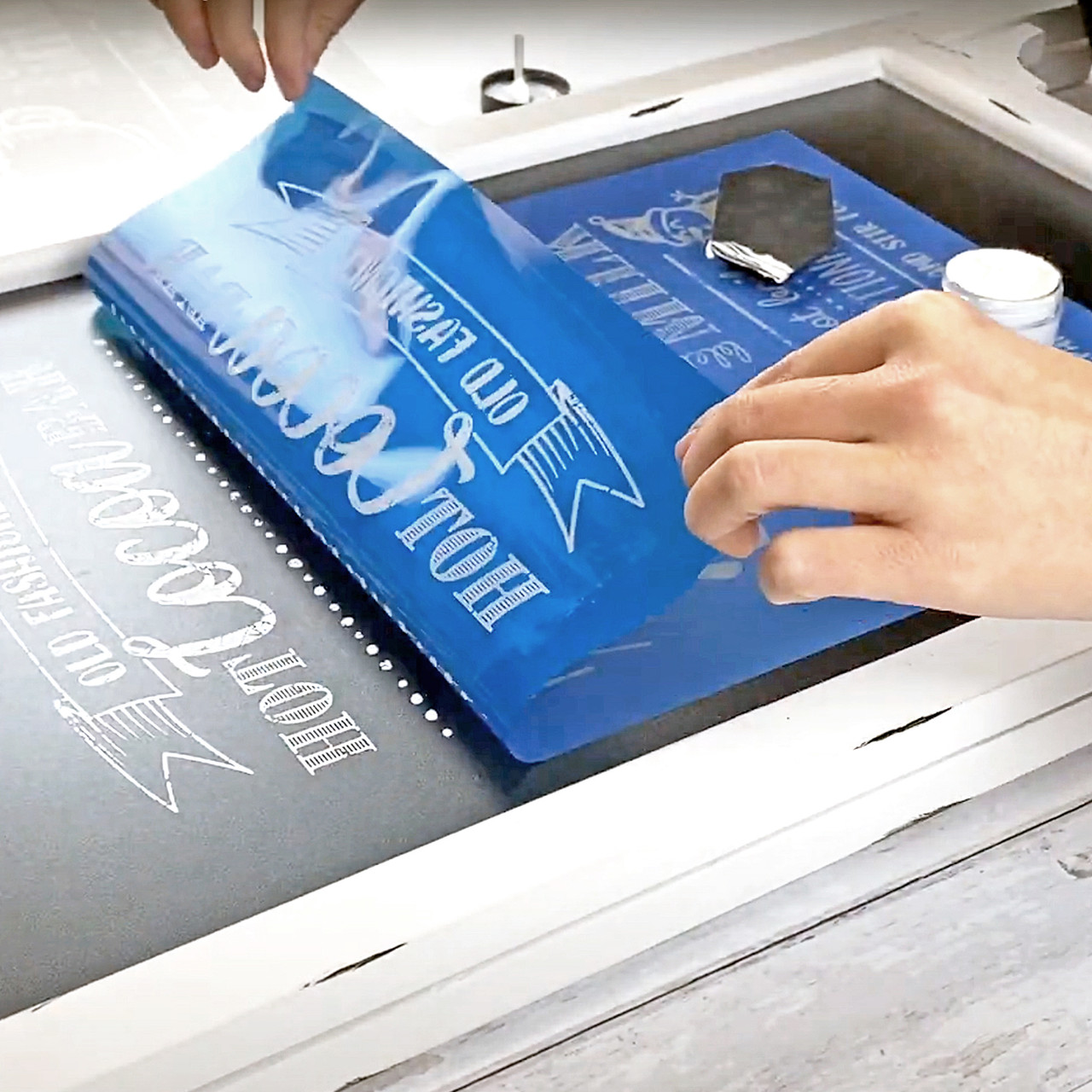Vintage Style Silk Screen Printing for Retro Fashion
Vintage Style Silk Screen Printing for Retro Fashion
Blog Article
Display Printing Uncovered: Everything You Required to Learn About Tee Shirt and Garment Printing Strategies
Screen printing is an interesting approach that integrates art with method, using limitless opportunities for creativity. Ready to check out the necessary components that make display publishing an art kind?
The Essentials of Screen Printing: Just How It Works
When you plunge into display printing, you'll find it's both an art and a scientific research. At its core, display printing entails developing a pattern, or screen, that enables ink to pass via just in particular areas.
Placement the screen over the material, after that utilize a squeegee to press ink via the display onto the garment. Each step is essential, and understanding them will raise your screen printing skills, transforming basic garments into distinct, expressive pieces.
Kinds Of Display Printing Techniques
When you comprehend the fundamentals of screen printing, it's time to discover the different techniques that can boost your styles. One popular approach is standard screen printing, where ink is pressed through a stenciled display.
One more option is plastisol printing, recognized for its longevity and vivid colors, making it a preferred for several brands. Experiment with halftone printing to develop gradient effects and complex designs.
Important Devices for Screen Printing
To achieve sensational results in display printing, having the appropriate equipment is essential. You'll require a durable screen printing framework, which holds the mesh that moves your layout onto the garment. Next off, spend in premium mops; these are crucial for applying ink equally across the screen.
Picking the Right Inks and Products
When picking inks and materials for screen printing, you need to take right into account the type of ink that functions ideal for your task. Consider material compatibility to guarantee your designs look excellent and last lengthy. Discover environmentally friendly ink alternatives to make your printing process more sustainable.
Kinds of Screen Inks
Selecting the right screen ink is necessary for attaining dynamic, sturdy prints that fulfill your project's demands. There are several sorts of display inks to examine. Plastisol ink is preferred for its convenience and ease of usage, supplying superb shade opacity on dark fabrics. Water-based ink, on the various other hand, provides a softer feeling and is environment-friendly, making it ideal for those seeking to lessen their environmental impact. Release inks get rid of dye from the textile, resulting in a soft, classic appearance however call for specific handling. Specialized inks, such as metallic or glow-in-the-dark, can add distinct results to your styles. Assess your task demands and select the ink that lines up finest with your preferred result.

Fabric Compatibility Considerations
Understanding textile compatibility is vital for attaining premium screen prints, specifically considering that different materials respond distinctively to various inks. When picking inks, take into consideration the material kind-- cotton, polyester, or blends. For cotton, water-based inks work well, using softness and breathability. Polyester, on the various other hand, often requires plastisol inks for far better attachment and lively colors. You may need to use a combination of both types if you're printing on blends. Always check your inks on example fabric to assure they stick correctly and maintain color integrity. Additionally, remember that textile weight and texture can influence the final outcome, so choosing the best ink and material combo is important for your task's success.
Eco-Friendly Ink Options
Eco-friendly inks are ending up being a prominent option for display printers who intend to reduce their environmental influence while keeping quality. When choosing inks, think about water-based inks, which are less dangerous and much easier to tidy up contrasted to typical solvents. These inks bond well with materials, providing vivid results without harmful chemicals. You could likewise explore eco-solvent inks that utilize fewer volatile natural substances (VOCs), making them a safer choice for both your health and the earth.
Additionally, try to find inks made from renewable energies, such as soy or vegetable-based choices. By selecting the right inks and products, you'll not just develop magnificent styles yet also add to a more lasting printing process. Make the switch, and your prints will show your dedication to the atmosphere!
Preparing Your Style for Display Printing

Submit Format Demands
To ensure your layout looks vibrant and sharp on material, you'll need to pay attention to submit format demands for display printing. Beginning with vector data like AI or EPS, as they can be scaled without shedding high quality. If you utilize raster pictures, select high-resolution files, such as TIFF or PNG, ideally at 300 DPI. Stay clear of utilizing JPEGs, as they can lose clearness when resized. Additionally, make certain your layout has a transparent background to stop undesirable white sides on your prints. Lastly, keep shade modes in mind; CMYK is common for screen printing, so convert your RGB designs as necessary. By adhering to these standards, you'll set your artwork up for an effective print.
Color Separation Techniques
Color splitting up is an important step in preparing your layout for display printing, and grasping it can significantly enhance your print high quality. You'll need to break your design right into individual colors, as each shade calls for a different screen throughout printing. Start by identifying all the shades in your layout and produce layers for each one. You can use software application like Adobe Photoshop or Illustrator to isolate and separate colors effectively. Be particular to conserve each layer as a separate file, commonly in a format like TIFF or PSD. This precision not just ensures accurate color representation however also streamlines the printing procedure. By paying attention to shade splitting up, you'll attain dynamic and expert outcomes in your navigate to this website screen-printed garments.
Resolution and Size
Accomplishing the very best cause display printing begins with assuring your design has the ideal resolution and dimension. Ideally, your art work needs to be at the very least 300 DPI (dots per inch) for sharp, clear prints. If you utilize lower resolution, your final product could look pixelated and unprofessional.
When it comes to dimension, think about the dimensions of your print area. Style your art work to match the final print size, preferably producing it in the actual dimensions you'll be publishing. This method, you'll avoid any type of unanticipated scaling issues.
Constantly inspect your layout in both vector and raster layouts. Vector graphics can be scaled without shedding quality, making them excellent for display printing. Preparing properly will assure your layout looks impressive on every garment!
Step-by-Step Screen Printing Process
Screen printing is a dynamic process that enables you to create vibrant designs on different surfaces. To get started, you'll need a display, emulsion, and your picked ink.
Pour ink onto the display and utilize a squeegee to push the ink via the pattern onto the textile. Lift the screen carefully and allow the print dry. You have actually efficiently display printed your style.
Tips for Effective Display Printing Projects
While you're diving right into your screen printing tasks, bear in mind that preparation is essential to success. Begin by collecting all your materials-- inks, squeegees, garments, and screens. A tidy office assists protect against unwanted errors, so neat up before you start.
Next, verify your artwork is high-resolution and properly sized for your garment. Examine your display for appropriate exposure and tidy it thoroughly to avoid smudges. When blending your inks, adhere to the producer's guidelines to achieve the right uniformity.
During printing, apply also stress with your squeegee for regular outcomes. Don't hurry; take your time to confirm each print fulfills your requirements. After printing, allow your garments dry completely before managing or packaging them.
Last but not least, always maintain an example of your work for future reference. In this manner, you can you could try this out evaluate your progress and enhance your techniques with time. Satisfied printing!

Often Asked Questions
Exactly how Lengthy Does It Require To Establish up a Display Printing Job?
Establishing up a screen printing task usually takes about half an hour to an hour. You'll prepare the displays, mix inks, and readjust the press. The time differs based upon intricacy and experience, so remain organized!
Can I Publish on Various Fabric Enters Utilizing the Very Same Strategy?
Yes, you can print on various material types making use of the exact same method, however you'll require to change your settings and inks. Some materials soak up ink in a different way, so exploring guarantees the finest outcomes for every material.
What Are Common Blunders to Prevent in Screen Printing?
When display printing, stay clear of common blunders like using the wrong ink, disregarding appropriate exposure times, or missing pre-press checks. Always check your arrangement and keep tidy screens to assure high quality results each time.
How Can I Correctly Clean and Maintain My Screen Printing Devices?
To correctly clean and maintain your screen printing devices, you ought to routinely clean screens with suitable solvents, inspect mops for wear, and ensure all devices are stored dust-free and completely dry. Consistency prevents costly repair services and boosts performance.
Is Screen Printing Eco-friendly Compared to Other Techniques?
Display printing can be much more eco-friendly than other techniques, particularly if you make use of water-based inks and eco-conscious materials. By selecting sustainable supplies and techniques, you minimize waste and reduce your influence on the world.
Display Look At This Printing Uncovered: Whatever You Need to Know Regarding T-Shirt and Garment Printing Strategies
At its core, display printing includes creating a pattern, or screen, that allows ink to pass via only in particular areas. Placement the screen over the material, after that utilize a squeegee to press ink with the display onto the garment. One popular approach is typical display printing, where ink is pressed through a stenciled screen.When choosing inks and products for screen printing, you require to take right into account the kind of ink that functions ideal for your task.
Report this page